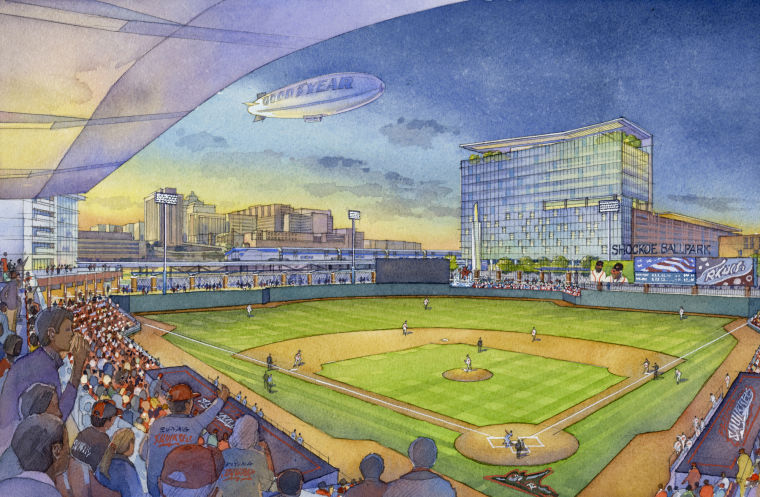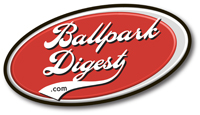
Richmond Mayor Dwight Jones says a proposed Richmond Flying Squirrels (Class AA; Eastern League) ballpark site is under archaeological and historical review, but opponents say the plan doesn’t ensure potential preservation.
A central issue in the ballpark-development plan has been the significance of the ballpark site in Shockoe Bottom, once the second-largest slade-trading site in the United States. There are certainly historically significant areas in Shockoe Bottom that deserve preservation, such as the site of Lumpkin’s Jail — the notorious “Devil’s half acre” where so many slaves were traded, jailed and died.
While preservationists did find what the assumed to be the jail site — under a parking lot — a detailed excavation didn’t yield a whole lot, reports the Smithsonian Institution: lots of the stuff you’d expect to be buried at an urban site (discarded household items, earthenware), but no items (shackles, whipping rings) that could be tied to the slave trade.
Which leads to a discussion of what could possibly be found at the ballpark site and if it will be enough to halt ballpark construction. Opponents of the ballpark are arguing that any sort of historical find should be enough to halt construction, but generally speaking that’s not the case. In Nashville, for instance, some artifacts were discovered during construction of the new Sulphur Dell ballpark. That wasn’t a surprise: the area was once an Indian burial ground and the site of the city’s first cemetery. Site prep at the Nashville Sounds (Class AAA; Pacific Coast League) was done in conjunction with an archaeology consulting firm — similar to what Jones is doing in Richmond — and nothing was found that would lead to a construction halt.
The archaeological investigation and historical review will be led by Dutton + Associates, LLC, a Richmond-based historical and cultural resources management firm that has conducted archeological surveys for public and private projects throughout the Commonwealth of Virginia. Archaeologists and historians from the Virginia Department of Historic Resources, local historical organizations, and area universities also will be involved.
As part of the archeological and historical investigation and review, Jones will appoint a panel of experts to review the research, data collection, excavations, found artifacts, and technical reports and other publications. A detailed accounting of the review process can be found here.
Still, anti-ballpark activists say it’s not enough. “The Mayor’s archaeological initiative is an obvious response to community requests and engagement and a departure from his earlier positions. But, like Ronald Reagan said, ‘Trust, but verify,'” said Kim Allen, who holds a doctorate in cultural anthropology and headed the Richmond Branch NAACP when it opposed ballpark construction. “It took sustained community engagement from several groups to get the mayor to make archaeology a priority and it will take even more vigilance from the community to make sure that this process is not rushed, is transparent and meets the standards of quality and professional archaeology. Likewise, I would hope that community engagement extends beyond the archaeological process and includes citizen input into the development of the site.”
Similar sentiments were expressed by Ana Edwards, who chairs the Sacred Ground Historical Reclamation Project and counts among her ancestors two women sold out of Shockoe Bottom in the 1840s: “Where is the commitment that construction work for a stadium would stop if significant historic resources are discovered? When the City arranged for the archaeological dig at the Lumpkin’s Jail site, no one expected that the Smithsonian Institute would consider it the most important archaeological find of the decade, but it was. What process was used to select the firm that’s already been at work for six weeks? Further, the plan calls for allowing the public to watch the excavations, but where is the mechanism for Black community input into what happens to a site so central to its history? Once again the mayor is reminding us that a top-down process is his preferred process.”
Of course, opponents are bringing up a whole slew of objections to the ballpark site that have been brought up before: that the Shockoe Bottom area is not suitable for a ballpark. We’re not talking about a pristine, untouched area here: we’re talking about an area that has been developed and redeveloped since the end of the slave trade. Lumpkin’s Jail itself was torn down in the 1870s or ’80s, and the site was used for other industrial uses before being paved over for a parking lot.
Speaking of process: the process of funding the ballpark continues, as the Richmond City Council looks at including funds for infrastructure work in the next budget. The site is slated for redevelopment even if a ballpark doesn’t happen, so city officials are From the Richmond Times-Dispatch:
The capital budget proposed by Mayor Dwight C. Jones for fiscal 2015 includes $13.6 million for infrastructure improvements that will smooth the way for the stadium-centered Shockoe Bottom development plan he proposed last year. The budget also includes $5 million for the proposed Shockoe slavery museum and $7.6 million to prepare the Boulevard for redevelopment….
City officials have said that, given the potential tax value of development on the Boulevard property, the work to make it amenable to developers needs to happen regardless of where the baseball decision lands.
The city is also working with the Flying Squirrels on a ballpark lease; it’s expected to be finalized this week. We do know the team will be on the hook for $1.7 million annually, but the Flying Squirrels will retain naming rights. Discussions about the exact development in Shockoe Bottom are in the final stages as well.
RELATED STORIES: Flying Squirrels ballpark plan advances; Votes on new Richmond ballpark set to start next week; Flying Squirrels add more locals to ownership; Richmond ballpark revenues could be used for other purposes; Richmond ballpark opponents: Map used to justify location is inaccurate; Richmond purchase of Diamond: Making way for Shockoe Bottom ballpark; Alternative plan pitched for Richmond’s Shockoe Bottom: No new ballpark; Flying Squirrels lease: $1.7M annually; naming rights could lower that number; Squirrels ballpark plan include hotel, apartments, grocery; Richmond quietly positions for new ballpark; Activists: Ballpark not best use for Shockoe Bottom; Poll: Squirrels home should be built next to current ballpark; Richmond: No vote on ballpark location; Flying Squirrels: Fans don’t know what they are missing; Richmond committee: Don’t put ballpark location to vote; Richmond ballpark location may be decided by voters; New Richmond ballpark: on or off?; Shockoe Bottom gaining momentum as Flying Squirrels ballpark site?; Progress made on new Richmond ballpark: McEacharn; MiLB squirrelly about new Richmond ballpark; Flying Squirrels: New ballpark still a priority; Flying Squirrels extend Diamond lease, setting stage for ballpark improvements; Experts: Downtown ballpark could revitalize Richmond; Squirrels: No plans to leave Richmond “at the present time”; Didn’t take long: Opposition rises to Richmond Shockoe Bottom ballpark site; Richmond ballpark discussion shifts back to Shockoe Bottom; Manchester in play as well; Richmond: Yes, we really do intend on building a new ballpark; Budget issues postpone Squirrels ballpark to 2015 at the earliest; New Richmond ballpark by 2014?; DiBella: Time to start talking new ballpark; Flying Squirrels throw out first offer on new ballpark
—-
Share your news with the baseball community. Send it to us at editors@augustpublications.com.
Are you a subscriber to the weekly Ballpark Digest newsletter? You can sign up for a free subscription at the Newsletter Signup Page.
Join Ballpark Digest on Facebook and on Twitter!
Follow Ballpark Digest on Google + and add us to your circles!
